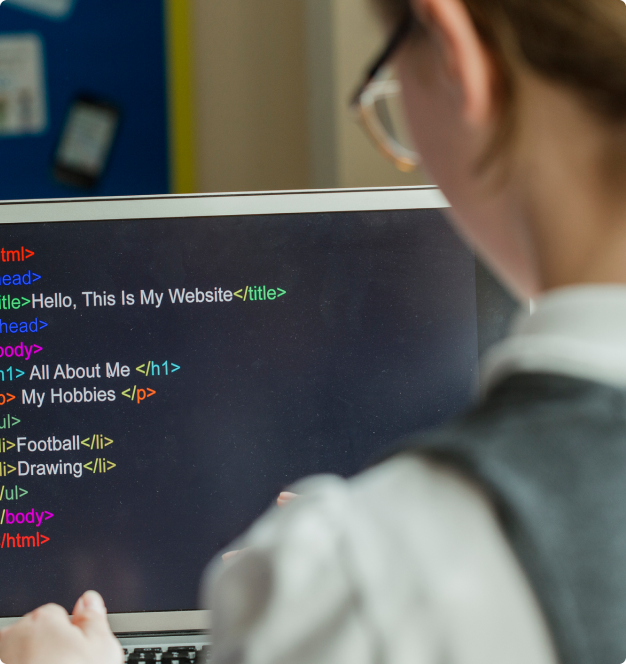Digital Literacy and
STEM Activities
What is Digital Literacy and STEM?
Technology advancements are revolutionizing every aspect of our lives. To thrive, people must understand how to use various technologies effectively to acquire, analyze, communicate, and create information. TechnoKids courses develop the skills students need today and provide a solid foundation that will guide them to future success. To make learning meaningful, TechnoKids uses a project-based approach to develop essential digital literacy skills and advance STEM education.
Digital literacy is the ability to find, evaluate, create, and communicate information in a digital format. It encompasses cognitive skills like critical thinking, creativity, and problem-solving, as well as technical proficiencies such as the ability to use digital tools, software, and computer systems. Students need these competencies to thrive.
STEM Education is an interdisciplinary approach to learning that combines Science, Technology, Engineering, and Mathematics to solve problems using real-world applications. It is important not only because STEM careers are growing and these skills are in demand, but also because the next generation of innovators must be able to combine knowledge from multiple disciplines.
STEM Education is an interdisciplinary approach to learning that combines Science, Technology, Engineering, and Mathematics to solve problems using real-world applications. It is important, not only because STEM careers are growing, and these skills are in demand. But also because the next generation of innovators must be able to combine knowledge from multiple disciplines.

Global Standards Driving Digital Intelligence Education
TechnoKids has been awarded the Powered by DQ seal. You can be confident that our courses deliver high-quality learning experiences. Our program meets global standards for digital literacy, skills, and readiness.
TechnoKids Collections align with multiple digital intelligence competencies within the DQ Global Standards (IEEE 3527.1TM).
Prepare Your Students
for the Future
TechnoKids uses project-based learning to promote scientific inquiry, mastery of technology tools, advancement of computer engineering, and the application of mathematical reasoning. Embedded within each course is a focus on encouraging creative artistic expression.
Establish an awareness of
STEM related careers
Through role play, students assume professions such as game designer, web developer, statistician, database administrator, financial analyst, or computer support specialist. These real-world learning opportunities encourage the pursuit of STEM occupations.
Form a diverse skill set required to
succeed in a complex workplace
Using an interdisciplinary approach, students blend learning from multiple subject areas to manage courses, synthesize vast amounts of information, collaborate with others, and disseminate information effectively. The ability to combine concepts and skills is essential for success in STEM careers.
Combine technology with
professional skills
Computer-based tasks include opportunities for students to enhance communication, leadership, teamwork, time management, goal setting, and self-monitoring skills. These are life skills that are necessary to compete in the workplace.
Prepare students for the
workplace of tomorrow
Project-based activities encourage the transfer of learning. The ability to adapt existing knowledge and skills to new situations is key to thriving in STEM jobs that have not yet been invented.
TechnoKids Supports
STEM Education
The S in STEM stands for Science. It is often considered the cornerstone of STEM education. This is likely because the scientific method is a logical way to solve problems and can be applied to most learning experiences. TechnoKids courses support inquiry-based skill development.
Promote Scientific Inquiry
In TechnoKids courses, thought provoking challenges encourage students to pose questions, formulate a plan to guide inquiry, gather data, interpret results, and present conclusions. This process develops the analytical skills needed to excel in STEM careers.
Improve Research Skills
TechnoKids courses include meaningful research-related tasks. These activities may have students conduct primary research by documenting firsthand experiences or secondary research by examining the work and findings of others. The ability to investigate a topic efficiently and critically is necessary for future endeavors.
Apply Technological Problem Solving
Empowering students with open-ended activities enables them to address real-world problems. In TechnoKids courses, students create tools, test the design, modify the process, communicate results, and recommend improvements. The ability to invent creative solutions is required in STEM occupations.
Expand Scientific Knowledge
TechnoKids courses individualize learning. Students can explore an area of personal interest. They gain a deeper understanding of scientific concepts by investigating environmental issues, the timeline of crucial scientific discoveries, or the interconnection of human activity. This inquiry can serve as a catalyst for pursuing careers in STEM-related industries.
The T in STEM stands for Technology. Technology is the software application or programming language used to complete a task. TechnoKids courses develop essential computing skills using Microsoft Office, Google Docs, Scratch, Python, and more!
Develop Mastery of Technology Tools
The TechnoKids Curriculum emphasizes skill building in areas such as word processing, spreadsheets, presentation, graphic design, video production, database management, and coding. A thorough understanding of how to use software applications is required in a digitized workplace.
Practice Responsible Digital Citizenship
Throughout TechnoKids courses, lessons highlight the significance of adopting responsible and ethical technology practices. Over time, this fosters the development of digital citizens who possess the integrity to apply STEM innovations for the betterment of society.
The E in STEM stands for Engineering. Engineers address real world challenges, improve everyday systems, and invent novel devices. TechnoKids courses target various types of engineers. Through hands-on learning students cultivate engineering skills by conceptualizing, analyzing, constructing, and testing ideas.
Spark an Interest in Software Engineering
TechnoKids courses foster the development of computational, logical, and analytical thinking. These crucial skills, coupled with problem-solving, persistence, and collaboration, are indispensable to software engineers. Empower students through enjoyable programming activities such as designing a game, chatbot, or AI prototypes. These learning opportunities can unlock pathways to rewarding careers in computer science.
Build Web Development Skills
Ignite a passion for web design using TechnoKids courses. Students can construct a web page using HTML or publish a website using WYSIWYG. Both of these activities may spark an interest in web development, possibly paving the way for jobs in mobile app development or ecommerce solutions.
Develop a Passion for Environmental Engineering
TechnoKids courses promote environmental stewardship and advocacy. Students raise awareness about problems such as recycling, fuel emissions, or plastic pollution. Such initiatives have the potential to inspire further exploration and study in the field of environmental engineering.
Highlight In-demand Jobs Related to Database Systems
Teach information management. Using TechnoKids courses, students can explore the real world application of databases, by building tables, forms, queries, and reports. These acquired skills serve as a foundation for career paths in database development.
Amplify Excitement for Computer Hardware Engineering
TechnoKids courses build foundational knowledge of computing devices. For instance, by participating in a simulation, students become computer specialists. This form of role play kindles further interest in STEM related occupations such as computer technician, network specialist, or robotic engineer.
Some educators say STEM. Others say STEAM. The A in STEAM stands for Arts. At TechnoKids, we believe the Arts are an integral part of STEM education. Creative thinking is the spark required to discover novel solutions, propose original ideas, or improve processes. Plus, artistic design is inherent to most STEM projects.
Support Creativity and Innovation
TechnoKids media arts courses engage students in visual storytelling, animation, and graphic design. These activities develop a creative mindset that can enhance their problem-solving abilities. This is important, as “out of the box” thinking is necessary to thrive in STEM careers where innovative solutions are required.
Encourage Exploration & Risk Taking
TechnoKids courses emphasize creative discovery. Digital art lessons encourage students to experiment with tools. This builds curiosity and confidence when taking risks, which are two traits required for inventing new STEM technologies.
Emphasize Human-Centered Design
Artistic expression often includes understanding the human experience. In TechnoKids courses, there is a strong emphasis on creating functional, yet visually appealing products for the end-user. In STEM careers, the capacity to empathize with others allows for the development of better solutions.
Pair Technology with Visualization
In TechnoKids courses, artistic challenges apply the principles of design to express an idea. For example, students may build a prototype to demonstrate a concept. The ability to transform an abstract notion into a product others can view and understand is vital for communicating new STEM related ideas to others.
The M in STEM stands for Math. This encompasses activities such as analyzing, calculating, and manipulating data, along with logical and computational thinking skills. TechnoKids courses highlight financial literacy, data analysis techniques, and the development of mathematical reasoning.
Cultivate a Positive Attitude Towards Mathematics
TechnoKids courses motivate students to learn by using real-life problems that are fun to solve. For instance, students apply mathematical reasoning to plan a bake sale, scorekeep a game, or launch a business venture. These practical and enjoyable activities can shape a positive attitude towards math.
Connect Math to the Real World
Students in TechnoKids courses assume the role of professionals. This allows them to understand the importance of math in many careers. For instance, they may play the role of social scientists, investors, or chatbot developers. These experiences foster an interest in STEM fields such as statistics, finance, or AI.
Incorporate Problem Solving
TechnoKids courses teach students to approach problems systematically. They learn how to divide problems into smaller parts and apply logical reasoning to find solutions. For instance, they might analyze chatbot data to improve the design, flowchart steps in a game, or apply design thinking to an AI prototype. These learning opportunities develop problem solving skills which are fundamental across all STEM disciplines.
Integrate the Use of Mathematical Applications
TechnoKids courses apply the use of mathematical applications such as spreadsheets, databases, and surveys. Students learn how to calculate, graph, and forecast data. Mastering these skills serves as a foundation for delving into more advanced STEM tools used for computation or data manipulation.
